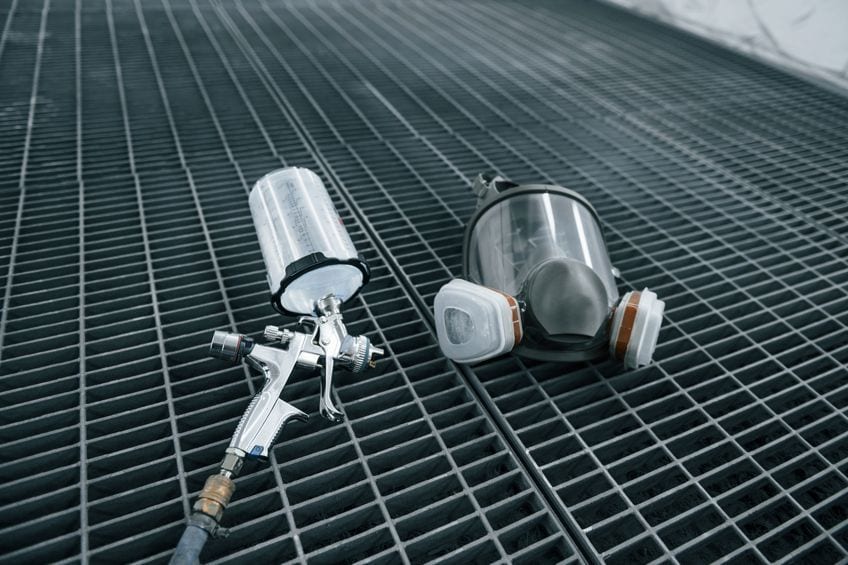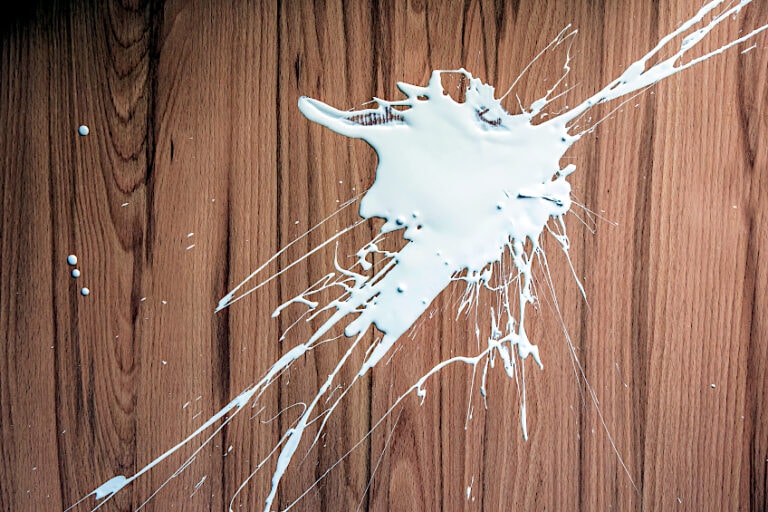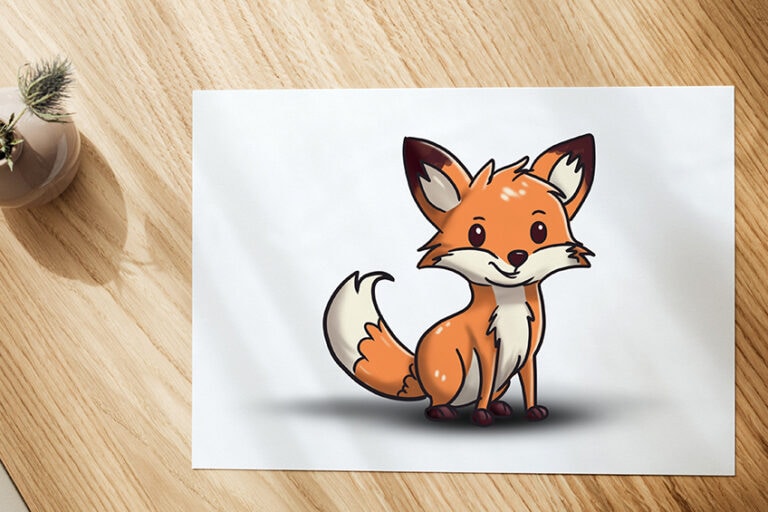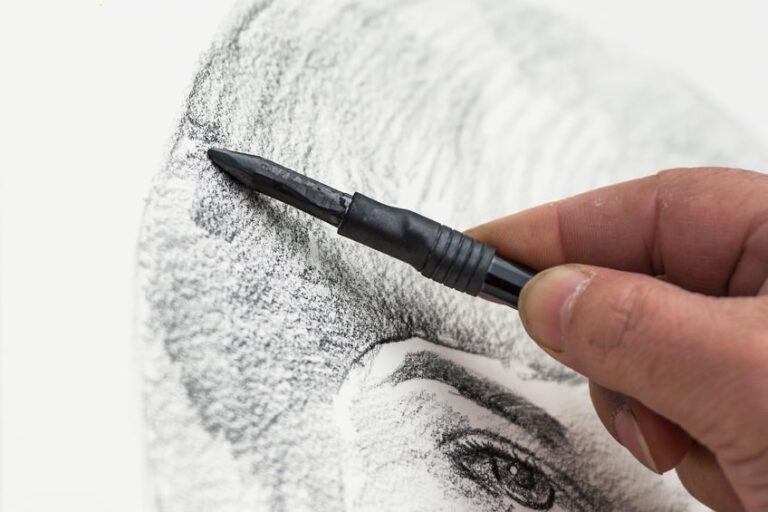Best Paint Respirator – Exploring the Top Respirators for Painters
This post may contain affiliate links. We may earn a small commission from purchases made through them, at no additional cost to you.
We have all at some stage tackled a job around the house or some form of home improvement. Certain tasks run the risk of exposing you to chemicals and dangerous toxins. Perhaps you were painting your furniture or your house, or using caustic or adhesive products, or spraying the garden with pesticides, or creating dust through sanding. All of these tasks can be dangerous to your health overall and you will have to wear the relevant protective equipment to ensure you do not inhale any of the harmful substances. The following article will assist you in understanding why wearing equipment is important and which types of equipment you will require for a particular project.
Table of Contents
- 1 What Are the Benefits of Wearing a Respirator Mask?
- 2 Types of Respirator Mask
- 3 Types of Respirator Filters
- 4 What to Consider When Buying the Best Paint Respirator?
- 5 What is the Best Spray-Painting Respirator Mask?
- 6 Using Your Respirator Mask
- 7 The Importance of Maintaining Your Respirator
- 8 Frequently Asked Questions
What Are the Benefits of Wearing a Respirator Mask?
Your life is valuable, and there is no financial value you can place on your health. Whether you are at home or work it is necessary to ensure you are safe and healthy. When required you will need to protect yourself from fumes, dust, and dangerous gases that may be deadly if inhaled. There is the risk to cause allergies, asthma, rashes, and other worrying breathing problems. The best option is to wear a fume mask when you take part in activities that give off dangerous chemicals, fumes, and dust. The equipment will provide you with protection for your respiratory systems such as your throat, mouth, lungs, and nasal cavities.
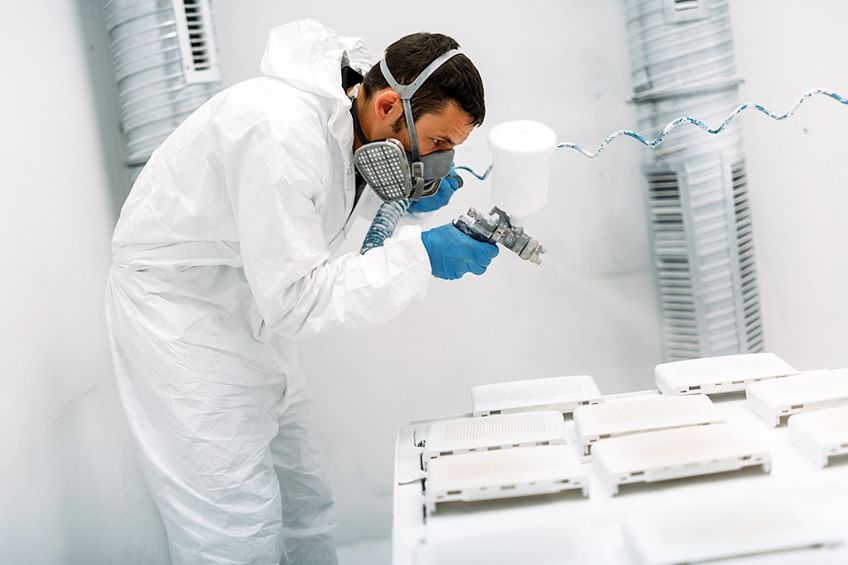
How Does a Respirator Mask Work?
Wearing a respirator mask will create a seal around your mouth, nose, or even your whole face and in doing so will filter out any fumes which may be harmful from entering your respiratory tract. They can also prevent you from breathing in any particles of dust which can cause lung problems, irritation, and in some cases death. Certain fume paint masks are created in a way that you have full-face protection which includes your eyes.
The respirator’s main purpose is to allow you to breathe in a safe ad normal fashion when dealing with potentially harmful and dangerous substances and chemicals.
The mask filters out all those dangerous and harmful substances before they can reach your lungs or bloodstream, ensuring you breathe clean and safe air. To have a better understanding, think for a moment how scuba gear allows you to breathe air as opposed to water, a fume mask operates with the same principle.
There are several different spray paint masks available, each has been created for a specific purpose. A lot of spray paint respirators have an element which is a filter such as canisters, paper, pads, and others have a device that captures the harmful particles, ensuring you remain healthy. It is much like an air purifier which filters out any dust particles, solvents, contaminants, or any dangerous elements in the surrounding air, providing you with clean air to breathe in.
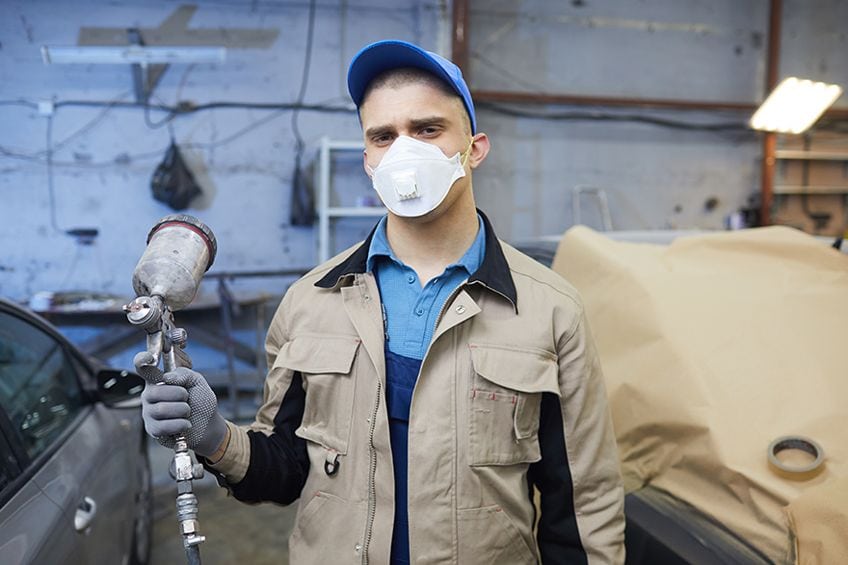
Keep in mind that there are limitations to all spray paint respirators, and you need to be aware of each respirator’s capabilities for painting masks, to ensure you have the correct protection you require for your given situation. You are only able to wear a respirator under certain conditions and will have to wear it properly by attaching the filter and cartridges as needed. If you choose to use a half-mask respirator, it is recommended you use organic vapor cartridges and pre-filters to provide the correct level of safety.
Types of Respirator Mask
There are many types of respirators for painting and it can seem a little overwhelming to know which is the correct one to buy. You will need to consider what type of task or job you want to tackle, such as using pesticides, painting, using dangerous chemicals to clean, or simply a small DIY craft or project.
It does not matter what the job is, if there are substances that are harmfully involved you will have to put on a protective mask before you start the job.
Keep in mind that not all respirator masks are the same, they have different levels of efficiency and you will need to look at different masks for different jobs. If you are simply a homeowner who needs to tackle jobs in the workshop or around the house, all you will require is a dusk mask (particulate filter) or a cartridge respirator. We have put together further details about the different masks available for purchase.
Positive or Negative Pressure Respiratory Masks
With these masks, the air you breathe in is either natural or automated. When wearing a negative pressure mask, you, the wearer creates your airflow by simply breathing in the natural, filtered air. Positive pressure masks are not normally used as spraying paint masks, while negative pressure masks have been designed specifically for DIY enthusiasts and spray painters. These masks are available as reusable masks, half-face masks, full-face masks, and single-use or disposable masks.
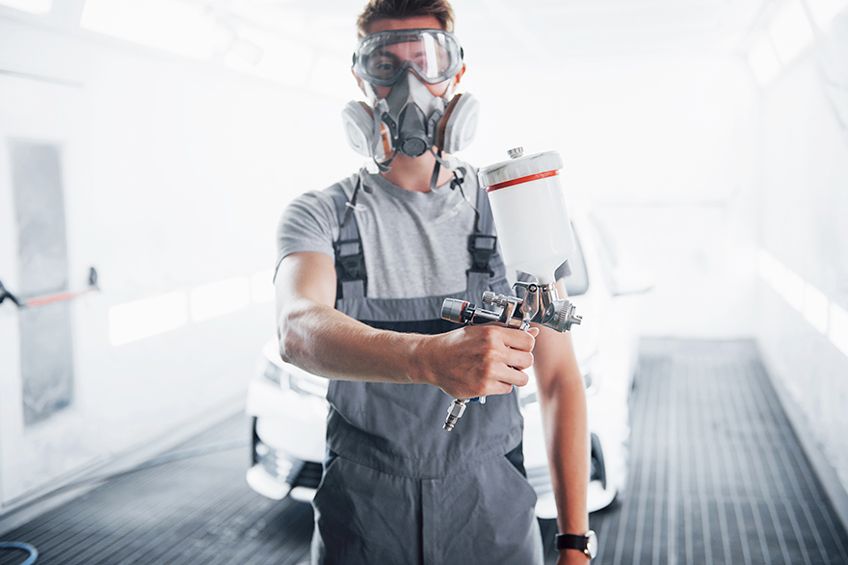
Half-Face Respirator Mask
As the name says the mask covers half of your face, being your nose and your mouth. There is a strap that encircles the back of your head, which is attached to the mask. An advantage of this respirator is that it is particularly comfortable. You can wear the mask under a welding helmet, but you will need to purchase some safety goggles so you are also able to protect your eyes. Another benefit of this mask is that it is reusable and all that is required is that you replace the cartridge and you can then use it once more.
These particular respirators are ideal for tasks that do not require eye protection. Though it is recommended you wear safety goggles as well. Half-face respirators are a lot more affordable than full-face respirators.
This form of respirator comes with a dual filter or single filter, which are made from the same materials as used in disposable dust masks. The majority of manufacturers make these masks in just one size, either large or medium. We recommend you use a face shield in conjunction with this mask for increased protection.
PROS
- Cartridges and filters are replaceable
- Lightweight
- Facepiece is reusable
- Will not hamper mobility
- Only requires a little maintenance
- Durable
- Comfy to wear
CONS
- Unfortunately, some contaminated air might leak through as this is a negative pressure device
- Does not offer protection for your eyes
- For correct facepiece size, test fitting is necessary
- Before you can reuse the facepiece you will need to disinfect it and clean it
- Certain eyewear may interfere with the mask
- It May be difficult to communicate when wearing the mask
Full-Faced Respirator Mask
This respirator offers you complete coverage of your face, including your eyes. This means that your nose, mouth, and eyes are given protection. This mask’s dual protection function protects your respiratory system, lungs, and eyes. The eye protection it offers is of a greater level than that offered by safety goggles. In addition, it is advantageous that the mask can be reused by simply replacing the cartridge.

A negative aspect of this form of respirator is when it is used for long periods it tends to steam up. They are therefore fitted with a cool flow valve that allows any moisture to be released and ensuring you can see clearly. The full-faced respirator is a lot more expensive than the half-faced respiratory mask and is also a lot bulkier. The full-faced respirator is ideal for applications such as furnace operations, sawing, chemical clean-up, spray painting, sanding, chemical handling, and grinding. If you wear prescription glasses you may prefer to use the half-face mask as it will be a lot easier to work with.
PROS
- Minimal maintenance required
- Offers protection for your eyes
- Cartridges and filters are replaceable
- Your full face is covered so you receive better protection
- The facepiece is reusable
- Durable
CONS
- If you wear prescription glasses the mask may cause problems
- Decreases field of vision
- May experience fogging up of the facepiece
- It can be difficult to communicate when wearing the mask
- To ensure correct facepiece size you will require test fitting
- Before you can reuse the facepiece it will require disinfecting and cleaning
This form of respirator provides complete coverage of the eyes, mouth, and nose offering you total protection from any types of irritants in the air. These masks can be used for an assortment of tasks, from spray painting to chemical handling, sanding, and grinding.
Air Purifying Respirator (APR) Mask
An APR mask allows for any isocyanates (chemicals), solvents, or dust particles to be filtered out that exist in the air around you. However, if the mask is fitted properly and you are using the correct cartridge. The necessary cartridge for adequately filtering out any solvents is an organic vapor cartridge. These cartridges contain HEPA (High-efficiency particulate air) filters that filter any dust particles. If you plan to work with paint, then the APR mask is the mask for you, with a dust pre-filter and organic vapor cartridge attached.
It is imperative that you change the filter and cartridge regularly, (about once a week) if you plan to paint every day, or when you begin to smell an unwanted odor or struggle to breathe properly through your respirator. This mask is available in both a full-face and half-face option.
These masks can filter out any chemicals or solvents, but only provide effective protection if you wear the mask correctly and you have fitted the relevant filters. If you are planning to do some spray painting, you will need to fit an organic vapor cartridge that has a pre-dust filter. Ensure to clean your filters often and check them before you use them.
PROS
- Minimal maintenance required
- Offers protection for your eyes
- Cartridges and filters are replaceable
- As it covers your full face, it offers better protection
- Facepiece is reusable
- Durable
CONS
- Fogging up of the facepiece may occur
- Your field of vision is reduced
- If you wear prescription glasses the mask may cause problems
- It can cause difficulties when trying to communicate
- To ensure the correct facepiece size you will require test fittings
- Before you can reuse the facepiece you will need to clean it
Supplied Air Respirator (SAR) Mask
These masks were designed for use in the military to filter out tear gas and mustard gas and are not normally used when working with spray paint. The air that you breathe comes from a tank as part of the respirator so it is not ambient filtered air. The SAR mask is mainly available in a full-face mask to adequately protect your mucous membranes.

Powered Air Purifying Respirator (PAPR) Mask
This mask is similar to the APR mask and as it requires cartridges to filter the air, yet pumps the filtered air to your mask from a pack that you wear on your back and can also be worn with a loose-fitting hood. If you are someone who has a beard this mask is ideal to provide you with maximum protection.
The PAPR mask allows you ease of movement and allows you the ability to mix your paint or clean your spray gun without the need to remove the mask, so it is very convenient to use.
This mask has air pumped to the facepiece from a backpack. The biggest advantage to this form of respirator is that you can move with ease when wearing it and you can perform your other functions without having to remove the mask.
PROS
- You can use it in oxygen-deficient areas
- Can be used in areas where filter respirators are ineffective
- Operating costs are low
- Minimal resistance to breathing
- Lightweight
- Great mobility without having to disconnect from the air supply
- Can be used for long periods
CONS
- You will need a trained professional to perform maintenance
- Protection is gone as soon as air supply is lost
- You will have to ensure that the apparatus is cleaned and maintained regularly
- The connected hose runs the risk of getting entangled
- Both the tank and the harness weigh a lot
Disposable Particulate or Dust Mask
This kind of mask is known as an air-purifying respirator and is perfect for filtering out small particles within the air. This form of the mask has a label on it indicating the level of protection it provides, which can be P95 of the N95 filter. This level indicates that you can eliminate 95 percent of the small particles present in the air, some of them even are N100.
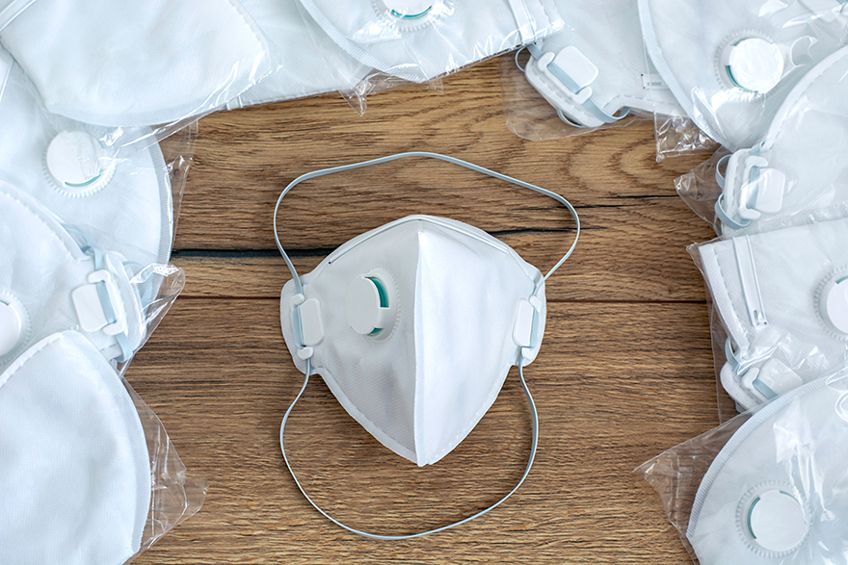
Sadly, these masks do not fit as snug to your face as a half and the full-face mask does, thereby limiting your protection. These masks have also been designed that they should only be used once and are therefore not reusable, so it is best you only use them occasionally. They are not fitted enough to filter out harmful chemicals, they are best suited to filter out dust particles.
PROS
- Does not hamper mobility
- Lightweight
- No cleaning or maintenance required
- Comfortable to wear
CONS
- A respirator that has an exhalation valve cannot be used in a sterile and clean environment
- There is no guarantee that it will keep out all the contaminated air
- Not allow offer head straps which are adjustable
- If you have a beard, it cannot be used effectively
- Does not offer protection against gasses and vapors
- Does not protect your eyes
This form of disposable respirator has been certified by the NIOSH with the relevant letters P, R, and N. They are available to purchase with or without an exhalation valve. The majority of manufacturers produce them in an assortment of sizes so that you can find the relevant size mask for either children or adults.
Types of Respirator Filters
Now that you are aware of the different types of respirators there are available you will need to select the best one to use for your project. To begin with, you must determine which impurities and chemicals you want to filter out with your respirator. You can choose which is better for you, the cartridge or particle filter. if your job will involve ammonia, acid gasses, or organic vapors then it is necessary to use a chemical cartridge. If, however, your work will involve allergens, pesticides, asbestos, pollen, mold, fibers, and so on, then you should use a particle filter.
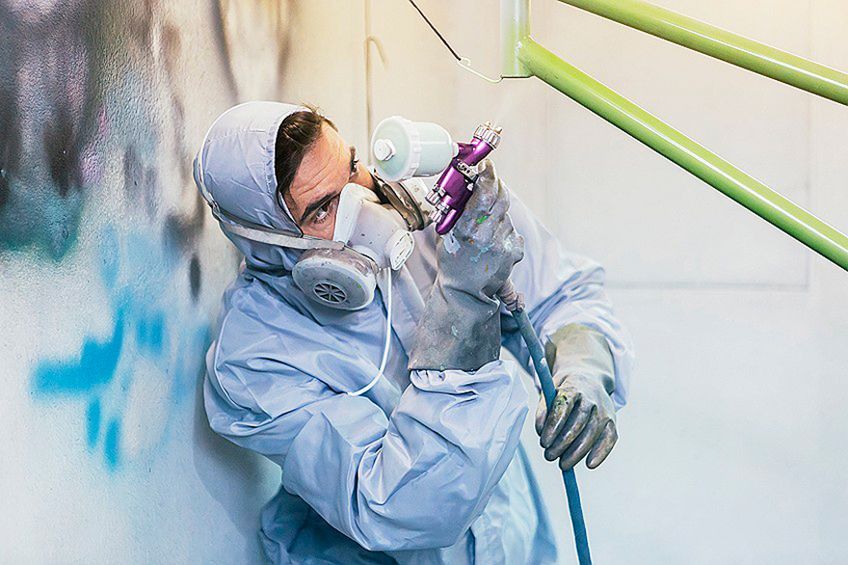
Particle Filters
You get particle filters with a disposable mask, though they can be reused if you insert a replicable filter as opposed to a disposable one. These filters filter out the substance which includes liquids, dust, and mists but they have been designed to filter out vapors, odors, or gasses. The NIOSH (National Institute of Occupational Safety and Health) has grouped the filters into three categories, which are identified by a letter of the alphabet followed by a number. The letters N, R, or P, indicate the resistance of the filter to the filtration of oil-based aerosols such as glycerin, lubricants, cutting fluids, and so on. Below is listed the resistance of the relevant filter:
- P: oil proof over eight hours
- R: for up to eight hours offers resistance to oil
- N: provides no oil-proof function
The table below summarizes this, illustrating the resistance to oil and the minimum efficiency level for each filter:
| Respirator Class | Minimum efficiency level |
| N95, R95, P95 | 95% |
| N99, R99, P99 | 99% |
| N100, R100, P100 | 99,97% |
Chemical Cartridges
These are fine filters, they have been manufactured to filter out acetone and paint fumes, but will not keep out the small particles in the air. They will however block out any vapors and harmful gasses such as methane, sulfur, chlorine, chloride, to name but a few.
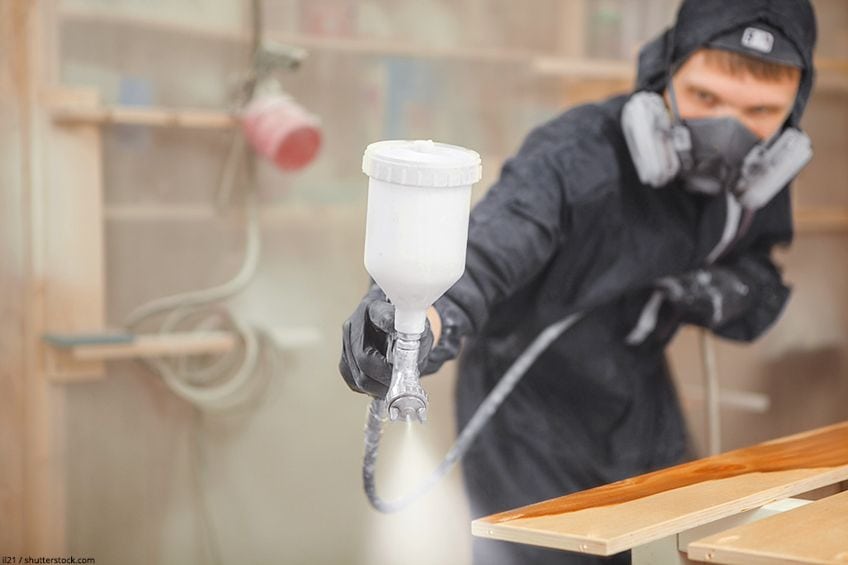
These particular respirators for painting and sanding are equipped with a carbon filtering material filter that stops the gasses and vapors from entering the mask. You can replace these filters. You are provided with perfect protection, as it is sealed on all sides, and will not allow any vapors or gasses to enter the mask. You can purchase these masks in two forms, being the full-faced mask and the half-faced mask. The full-faced mask offers you coverage for your whole face, meaning complete protection.
Combination Cartridges
This cartridge contains both a particle filter and a carbon filter which can block any vapors and gasses, while also filtering out dangerous particles in the air. The initial carbon filter filters out the vapors and gasses, while the second particle filter filters out any particles in the air such as pollen, mold, paint, mildew, or spores.
For those of you who want all-around protection from a respirator, we definitely recommend combination cartidges.
What to Consider When Buying the Best Paint Respirator?
It is time for you to head out and purchase your respirator, but first, you will need to decide what type to buy, you will need to first consider a few things that will make your purchase a lot easier. You will need to know the form of filtration system you require; will it block out all of the unnecessary chemicals, vapor, and dust? You also need to take into consideration how the mask will fit your face, as you might be wearing the mask for an extended period. You will need to take note, does the individual have facial hair and, or wear prescription glasses? All of these factors will impact how the mask seals around your face. What follows are a few aspects you should consider to select the best paint respirator for you.
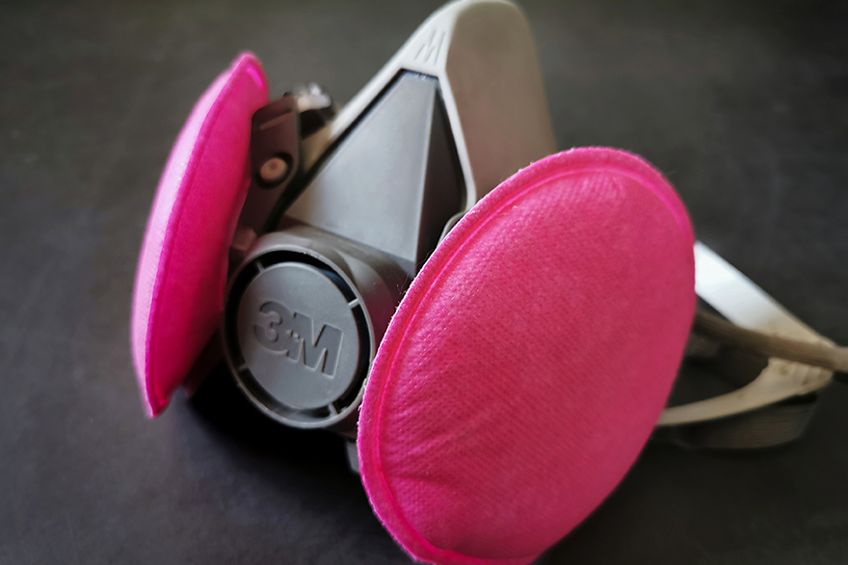
Filtering Ability
You will need to consider how much your filter will be able to filtrate, and then purchase one which provides you with the maximum protection for the work you will be doing. This is important relevant when it comes to filtering toxic gases and other particles in the air that can be harmful to you.
Respirator Filters
The respirators filters are particularly important when you are dealing with spray paint. You need to determine if the built-in filter can, on its own, filter out the contaminants, chemicals, and allergens that you will be exposed to. The filters which are integrated can filter vapor and gas, which will assist with paint fumes, though they do not protect you from dust and other particles in the air. So, if you plan to do a significant amount of painting and sanding, then we suggest you purchase a combination or dual cartridge that can stand up to both vapors and particles. Another option is to select a particular filter that can filter out large particles and purify the air but will not protect you from gases and vapors.
This is an important decision for you to make before you can purchase your respirator.
National Institute for Occupational Safety and Health Approval (NIOSH)
There is an assortment of products available which claim they comply, but the product you have purchased must have the NIOSH certification. The filters that have received this rating are tested, regulated, and approved, and guaranteed to offer you protection from hazardous substances such as chemicals, toxic gases, fumes and can ensure you are safe.
Reusability
One might think it is simple to buy yourself a disposable mask, and when you have finished using it, simply throw it away. Yet, keep in mind that these types of filters are not very effective in offering protection from fumes and vapors. Try to rather purchase a respirator that has replaceable filters and cartridges, and is reusable. You will need to be careful to ensure that you change them regularly otherwise you might end up breathing in toxic fumes. You need to ensure you adhere to the maintenance instructions for your respirator and keep in mind the length of time they are still reusable.
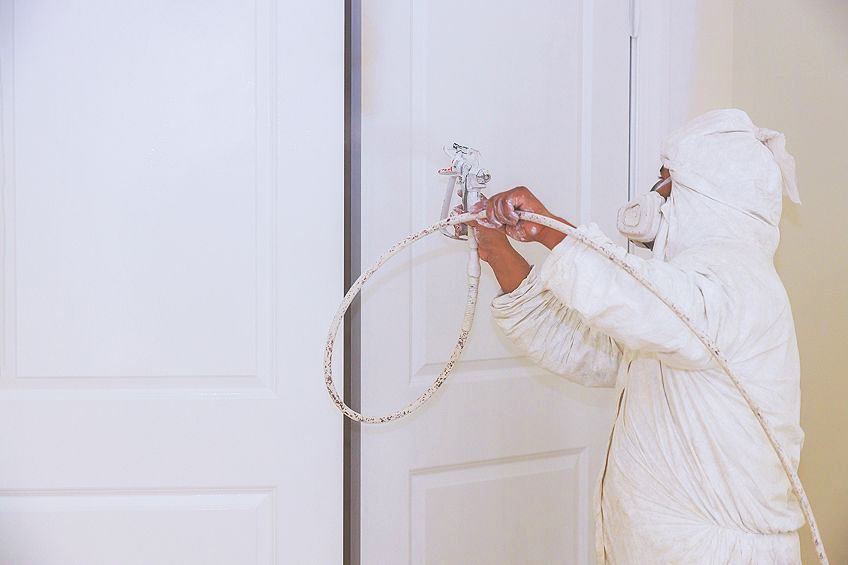
Size and Fit
You need to have the right size mask for you, so that it is not too big or too small, either of which would compromise your safety. To keep the mask tightly sealed around your face all respirators for painters are equipped with adjustable straps. While you want the mask to seal correctly, you need to ensure that your circulation is not cut off and no air is allowed anywhere else.
Comfort
A comfortable mask is very important, particularly as you will be wearing the mask for a significant amount of time each day, anywhere up to 8 to 12 hours. Your eyes should be able to focus on the task at hand and you should have the maximum field of view. Certain masks have a covering that makes them part of the mask which touches the nose, softer. When wearing the mask, you should never experience trouble breathing.
In terms of weight, you want to buy a pretty lightweight mask, ideally, something which weighs less than a pound but in no way compromises the required safety specifications.
What is the Best Spray-Painting Respirator Mask?
You must have the best respirator mask when tackling your spray-painting job as they protect your lungs from fumes and paint particles. Unfortunately, not all spray paint respirators are the same so you must need to have the relevant knowledge of which to use for what project to select the best paint respirator. Say for example you are doing paintwork, either inside or outside, you would need a gas respirator. While you will only require a particle filter if you will only be exposed to dust or light mist. We have put together details on a few, highly recommended respirators to help with your decision.
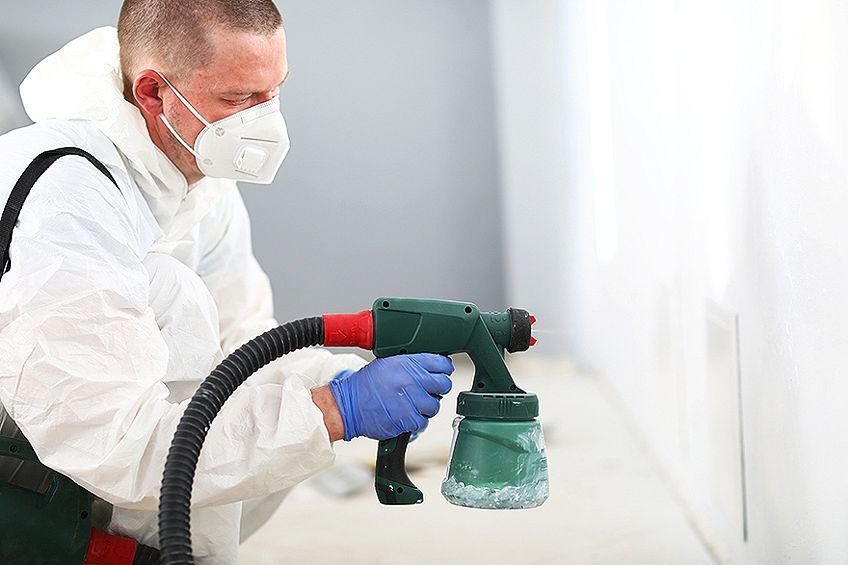
The Best Half-Face Respirator Spray Paint Mask: HONEYWELL Reusable Half Mask
This mask is perfect for use by either DIY or professional spray painters and welders and protects from any dangerous airborne irritants. The mask has a modern design that offers a low-profile cartridge that offers you a greater and better field of vision, making it possible to even do close-up detailed work with ease. The mask is made from silicone and elastomers which are both latex-free, so it is not only comfortable to wear but will not cause any form of skin irritation. The pressure points on your face are eliminated by the contoured sealing flange which means you can wear the mask for long periods comfortably. You will be able to breathe properly thanks to the exhalation valve being located in the correct place.
- Includes 2 multi-contaminant cartridge combos for reliable protection
- Cartridges and filters are easily replaced so the facepiece can be reused
- Contoured face seal with variable thickness for optimal seal
You can replace the filters and cartridges with ease, so this means the mask is reusable and is compatible with any of the N-Series types of filters. The mask is quite flexible on the bridge of your nose, has strong support for your chin, and the strap feature offers great support. The half mask is available in two sizes, being medium and large, which will cater to most users. You will receive pre-filters and organic vapor cartridges in the pack, both for your protection. When tackling oil mist the mask is rated to provide eight hours of safety and also cares a rating from NIOSH of OV/R95.
PROS
- Comes with pre-filters and vapor cartridges
- Fits well on the majority of users
- Provides a large field of vision
CONS
- The material used is a little rough, it could have been a bit softer
Best Full-Face Respirator mask for Spray Painting: 3M Reusable Respirator
This mask can be considered the best brand available and will offer you protection for your lungs from mold, gases, chemicals, paint vapors, and dust, while also protecting the sensitive skin on your face and your eyes. It is the perfect mask to use when you are spray painting outside, or when you are working in a confined space and you require protection from the harmful paint fumes. One would assume that the mask is heavy and bulky as it is a full-face respirator but in fact, it is the opposite. The mask fits closely on your face and is lightweight, while also being easy to use. The mask has a durable silicone face seal which decreases the pressure on your face. The mask is equipped with a cool flow valve that allows cool air to enter the mask, which ensures no overheating or fogging occurs during the period you are wearing the mask. Your exhaling is guided downwards thanks to the unique center adapter.
- Silicone Face Seal for enhanced comfort and durability
- 3M cool flow valve helps provide cool, dry comfort while painting
- Unique center adapter directs exhaled breath and moisture downward
You can use the mask as a dual combination, which means it will protect you not only from mold and dust but also from vapors and paint fumes. Keep in mind though that you will be required to purchase the filters separately when you order your mask. The mask is available in three sizes, while the mask itself remains one size, the face seal and straps are available in different sizes which you need to check when purchasing. You will have a wide view when using the mask thanks to it having a large lens, which also offers you amazing visibility. Any distortion is limited when you look from right to left thanks to the lens having an integrated optical correction.
PROS
- When using the right filters, you will have full protection
- Comes with a cool flow valve
- Provides both negative and positive pressure systems
- Offers protection for both your lungs and eyes
- Wide field of vision
CONS
- If you wear prescription glasses you are unable to use the mask
- You will have to purchase the filters separately
Best Dust or Disposable Respirator: 3M Paint Sanding Cool-Flow Respirator
If you are looking for an affordable disposable mask then this is the product for you, do not make the mistake of buying a cheap flimsy paper mask that does not give you the protection you require. This respirator while being affordable will still provide you with the desired protection. While the mask is not recommended as a respirator for painting it will provide you with adequate protection from sand particles, pollen, mold, dust, and is perfect to wear when you are sanding wood.
- NIOSH approved N95 for at least 95% filtration efficiency
- 3M cool flow valve helps reduce heat buildup inside the respirator
- Adjustable M nose clip helps ensure a custom, secure seal
The mask is single-use and disposable but has the advantage of being equipped with a nose clip that is adjustable meaning it is very comfortable to wear. The mask is equipped with a cool flow valve that stops heat from building up underneath your mask. It also has advanced electrostatic media this does not cause any additional pressure on your breathing while capturing particles. You receive 10 in a package of these masks and they come in a one-size-fits-all set that has two bands that are adjustable to fit around your heat.
PROS
- Comes with an adjustable nose clip
- Extremely lightweight
- Comes with an Advanced electrostatic media
- Well priced
- Has a cool flow valve
CONS
- Offers no protection from solvents and fumes
- Only good for one use
Using Your Respirator Mask
Now that you have a better understanding of what a respirator mask is and why it is necessary to wear one, we have put together some guidelines in terms of using your respirator mask.
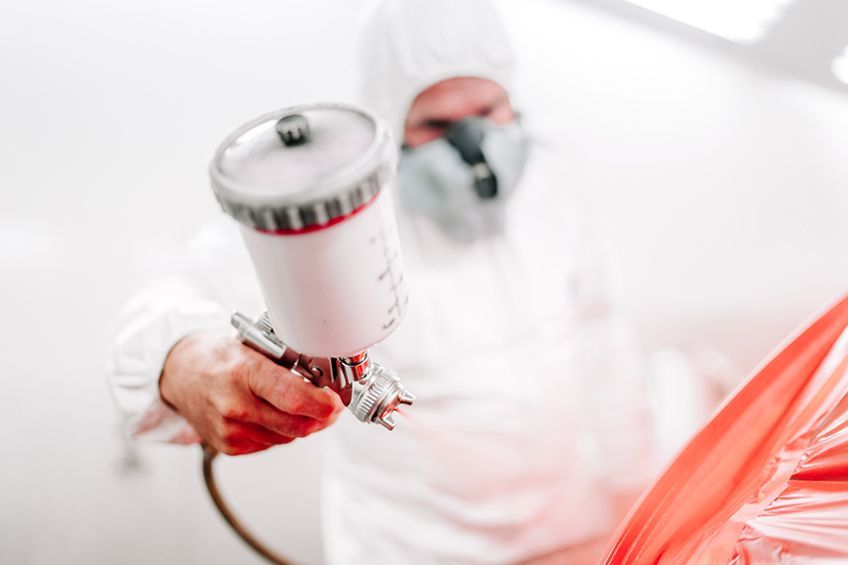
Some Safety Tips When Using Your Paint Respirator Mask
Your respirator mask must fit snuggly against your face. Much like shoes, whereby one pair does not fit everyone, one respirator will not fit everyone. You will need to try the masks on until you find the correct one that fits you tightly to your face and is comfortable. It could leak if it does not fit you tightly, resulting in you breathing in air that is contaminated and your lungs will no longer be protected.
Men with beards may struggle, as the facial hair can get in the way and stop the respirator from fitting tightly to their face.
Always consult and follow the manufacturer’s instructions, which will assist you in using the respirator correctly. You will need to ensure all the parts of the respirator are in a good condition before you put it on, you can consult the manufacturer’s inspection list. Never use a broken or dirty respirator, rather have it repaired or clean it before using.
How to Put on a Half or Full-Face Respirator Mask
Begin by ensuring that the nosepiece is positioned upwards, and then fix the respirator under your chin. Position the top strap above your ears and over your head. Position the bottom strap on your neck just below your ears. Finally, adjust both the straps and the facepiece until they feel comfortable and fitted.
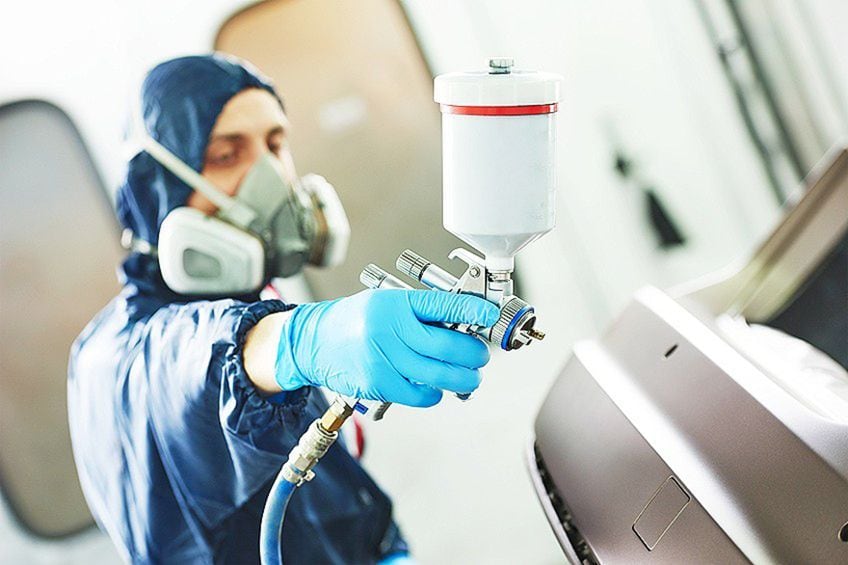
How to Put a Filtering or Dust Respirator Mask
Hold the mask in your hands, ensuring that the nosepiece faces towards your fingertips. Use the mask to cover your nose and mouth. Position the top strap above your ears, over your head. Position the bottom strap on your neck, just below your ears. If your respirator has a metal nose piece you can mold it using your hands to securely fit your nose.
Finally, adjust the straps and facepiece until it feels comfortable.
Performing a Negative Pressure Test
Before you begin painting, you need to perform a negative pressure test to be certain the respirator seals correctly over your face. The opening of the cartridge needs to be covered, and you can use the palm of your hand to do this. To allow the facepiece to slightly collapse, inhale slowly. Then hold your breath for roughly ten seconds.
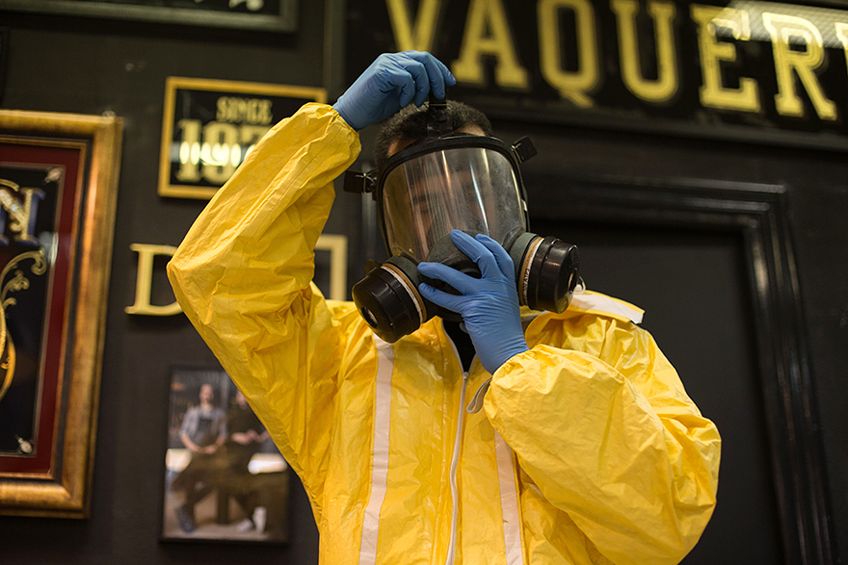
You should then notice the facepiece remains in a collapsed position and that this is no leaking inwards, which means your respirator is fitted correctly. The facepiece will need to be readjusted if you notice a leak.
How to do a Positive Pressure Test
As well as a negative pressure test, you need to perform a positive pressure test. The exhaust valve needs to be covered, again, you can use the palm of your hand. Breathe slowly into the facepiece. The respirator is correctly sealed if you feel a small amount of pressure building up inside the facepiece.
Should you note a leak you will need to readjust your mask and then repeat the process until you are happy with the seal
The Importance of Maintaining Your Respirator
You will have to look after your respirator and ensure regular maintenance, for your well-being and health. After each use you will need to sanitize and clean it as a dirty respirator can result in dust, isocyanates, and solvents being in contact with your skin. As always consult the manufacturer’s instructions to ensure you are sanitizing and cleaning correctly. You will have to strip the respirator and wash the parts separately after each use, using warm soapy water. Afterward, rinse the parts in fresh clean water and allow them time to dry before you put the respirator back together.
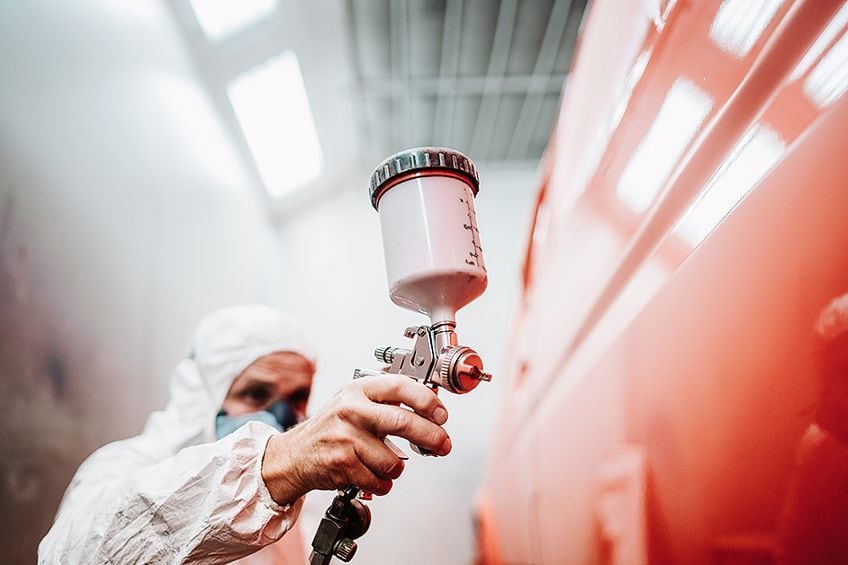
Once again, we recommend you follow the manufacturer’s instructions when sanitizing your respirator, though it is possible to use alcohol wipes to wipe down the parts. Afterward, you will have to put your respirator in a sealed plastic bag to stop any chemicals or dust contaminating it. you will need to look at all of the filters often to see if they are soiled or damaged, in which case they will need to be replaced. If you pick up an odd smell or strange taste, check your filters immediately as there is a good chance that they are damaged. When storing your respirator, it should be kept in a dry and cool place, as you want to avoid getting moisture into it as it will then be unusable.
We hope that this article has provided you with a clearer understanding of what a respirator mask is, why it is necessary to wear one, and assists you in selecting the correct respirator for your requirements.
Frequently Asked Questions
Which Is Better a Half-Face or a Full-Face Respirator?
The answer is dependent on the types of elements you will be exposed to, as well as the level of protection you will require. If you will be potentially exposed to dust, paint fumes, or another form of a toxic substance, we recommend you use a half-face mask. If you are a professional or DIY specialist and you require complete protection which also needs to protect your eyes from any dangerous elements you are exposed to, then we recommend you use a full-face mask.
Can a Spray Painting Respiratory be Used for Woodwork or Sanding?
If you have purchased a top-end paint respirator, then it will work for whatever job you are tackling maybe, as long as you are utilizing the correct filter.
When Should the Filters be Replaced?
The majority of filters have roughly a five-year shelf life. That being said, once you have opened the packet it is necessary to change the filters every six months. You will need to replace any soiled or damaged filters immediately as they could impact your safety.
How Can I Select the Correct Size Respirator?
The majority of respirator brands are available in three generic sizes, namely large, medium, and small. Children and young adults usually require a small size. The medium size is versatile and can fit almost anyone but it is necessary to adjust the straps accordingly so that the mask fits tightly. If you notice that the straps have been adjusted as much as possible and the mask is still not fitting correctly, then upsize or downsize the mask accordingly to find one that fits correctly.
Larissa Meyer is a 32-year-old mother from Michigan and creative spirit since childhood. Her passion for painting and drawing has led her to an education as an illustrator and a career as a freelance graphic designer. She has a Bachelor of Fine Arts in Illustration and a degree in Graphic Design. Larissa is a talented artist who is able to master a wide range of styles and techniques to bring her artistic vision to life. Her greatest passion is currently fluid painting and epoxy resin art. Larissa’s love for art and her knowledge and experience in illustration make her the perfect Creative Director for our fluid-painting.com team. She is the creative head of our team and shares her passion and knowledge with our community through articles and tutorials.
As a mother of a 2-year-old daughter, Larissa also understands the importance of fostering creativity in early childhood. She uses her experience and knowledge to help other parents inspire their children and develop their artistic skills as well.
Learn more about Larissa Meyer and about us.

